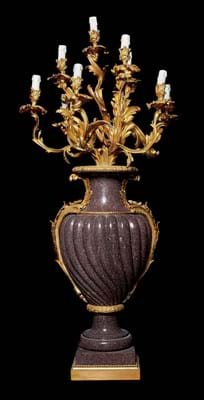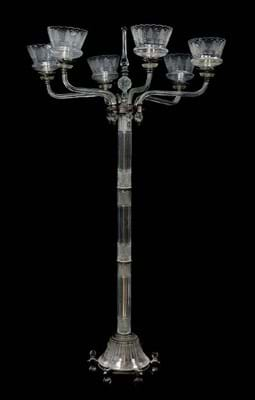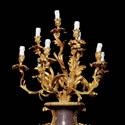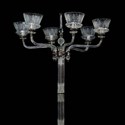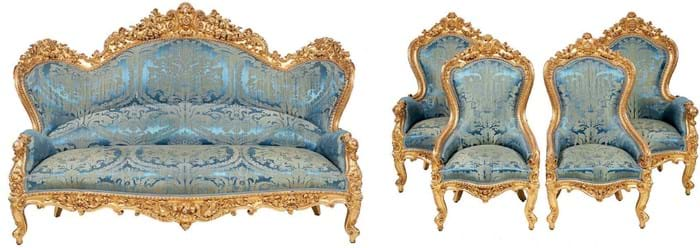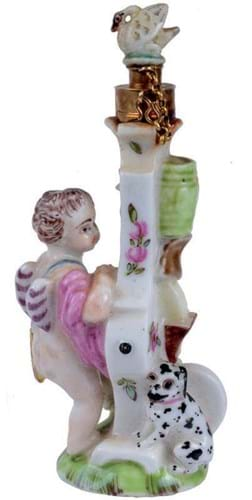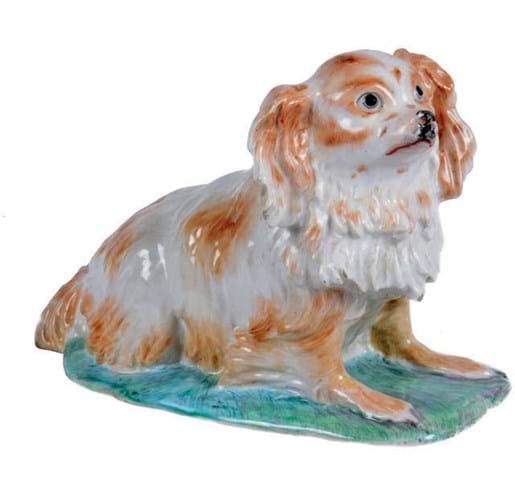The £357,000 catalogue posted a selling rate of 83% across 300 lots.
The core of the offering was a single collection of decorative furniture and lighting described by Pratt as “flamboyant, big and bold”.
There was considerable interest from across Europe but time and again on the top lots this translated into underbidding against the London trade and UK private buyers.
Monumental candelabra
Such was the case in the best-seller at the auction on February 19, a pair of monumental 10-light porphyry candelabra with gilt-bronze mounts in Louis XV taste.
They were probably French and from the second half of the 20th century. The 5ft 1in (1.54m) tall extravaganza went to a London dealer above-estimate at £22,000.
Of similar date and appeal was a gilt-bronze chandelier in the Louis XVI taste going over estimate at £8500. The 6ft 4in (1.93m) tall piece featured an ovoid body mounted with urn finials and satyr masks and three scrolled branches, each cast with two naked maidens holding aloft seven-branch foliate and fluted light fitments.
More restrained were a late-19th or early-20th century pair of cut-glass and silver-plated standard candelabra and a c.1900 gasolier, each stamped F&C Osler.
Founded in 1807 in Birmingham by Thomas Osler, the firm expanded under his sons Follett and Clarkson to achieve worldwide renown for its cut glass furniture in particular.
“The Osler name is synonymous with exceptional quality and represents a rich tradition of English 19th century glass manufacture,” said head of sale Ashley Matthews.
“When one bears in mind the fragility of these items they have survived in a remarkably good condition.”
Given a broad £6000-10,000 estimate, the 5ft 7in (1.71m) high, six-light candelabras went to the London trade at £12,000.
The trade were back in action for the following lot, a cut and moulded glass eight-light gasolier with silver-plated mounts, but were beaten by a private UK bidder. Measuring 3ft 2in x 3ft 7in (98cm x 1.1m), it was pitched at £3000-5000 but sold at £12,500.
Suite in Louis XV style
The top attraction among the seating furniture was 19th century carved giltwood and composition salon suite in the Louis XV style.
It comprised a pair of sofas, set of four elbow chairs, and a set of four side chairs, each with backs headed with lion masks and frames carved with leaf and fruit decoration.
The suite was estimated at £4000- 6000 and went to a London dealer buying for his own use at £14,000.
Also sold to the London trade was a pair of Napoleon III 4ft (1.22m) wide, amboyna and tulipwood banded side cabinets (£3500) and a 7ft (2.12m) wide kingwood and marquetry credenza c.1875 with a breche violette marble top (£4500). Both pieces benefited from the addition of inset Sèvres-style porcelain plaques.
Decorative pedestals were in demand, the best being a set of four 19th Italian marmo cipollino and white marble mounted columnar examples. Standing 4ft (1.23m) tall, these were estimated at £2000-3000 but after a battle between six phone bidders, an English private buyer won at £8500.
A number of English furniture items left cautious estimates behind courtesy of English private buyers. Among them was the late 19th or early 20th century mahogany twin pedestal partner’s desk copying the Chippendale desk supplied to Nostell Priory, Yorkshire. It was estimated at £3000-5000 but sold at £11,000.
An 8ft 2in (2.48m) high satinwood breakfront wardrobe banded in tulipwood and rosewood, originally retailed by Maples c,1900, took a five-times-estimate £4500 while a William IV mahogany serving table with a bowfront acanthus-carved top pitched at just £400-600 sold at £4200.
Mirror and clock
A huge and decorative Scottish carved giltwood overmantel mirror also demolished the estimate.
With a heraldic lion emblem and the Clan Gregor motto S Rioghal Mo Dhream (Royal is my race) on the surmount, the 8ft 6in high, 6ft 6in wide (2.60 x 1.99m) mirror pitched at £600-800 was an English private buy at £4500.
Horology meant a return to the Continent for the sale stars including a late 19th century Vincenti & Cie mantel clock. With an eight-day bell striking movement stamped with the Medaille D’argent roundel, it was estimated at £700-1000 but, against bidding from Poland and the Netherlands, it sold to a London dealer in the room at £8200.
Porcelain collection
Largely built on one collection, Dreweatts’ February 19 sale also benefited from a single collection of 18th century English porcelain including 13 of the ‘Chelsea toys’ catalogued as ‘Charles Gouyn St James’s factory type’.
The Huguenot jeweller’s work after leaving the Chelsea factory he helped set up in 1745 was not really identified as a separate factory until Bernard Dragesco’s researches were published in 1993.
Best of the eight scent bottles – seven of which sold at a collective over-estimate £16,900 – was the example shown above.
Dated c.1755, the 3in (8cm) tall bottle, offered in its original shagreen case, went to a London dealer at £4800 against a £2500-3500 estimate.
Much more affordable were three fob seals, best of which was a c.1755, 1¼in (3cm) tall example modelled as a piper. Inscribed J’Apelle Ma Berger and set with a hardstone seal, it went above hopes at £350.
From the same collection, a c.1775 Chelsea etui, a 4½in (12cm) cylinder painted with flowers, surmounted by a caged hen and chicks and inscribed Aimons Nos Petits, tripled the top estimate selling to a bidder from Egypt at £4500.
The biggest surprise from the collection, however, was a Derby porcelain model of a Bolognese terrier. It was in the Meissen style and, although dated c.1800 in the catalogue, probably an earlier piece from the third quarter of the 18th century.
Against a £300-400 estimate the 8½in (22cm) long dog sold to a London dealer at £8200.


